Tramscape Tramway
Photographs
Florence, Italy :
5th-8th April, 2008
Florence is one of the jewels of European heritage : a powerful republic
in the 15th century and under the guidance of the Medici family became the centre
for Renaissance art and architecture and home to such names as Michaelangelo,
Botticelli, the architecht Brunelleschi and the exploreer Amerigo Vespucci after
whom the New World west of the Atlantic Ocean was named. The entire inner city
is designated as a UNESCO World Heritage site, and is full of magnificent palaces,
churches and the magnificent Duomo (cathedral), all housing works of art and
sculpture by the grand masters - and their ornate tombs. Tourists flock to Florence
in their droves - just to wonder at the magnificent treasures, and in many cases
to study them in detail. At whatever degree of detail, it is unlikely that anyone
would leave unimpressed.
Whilst almost a "living museum", it
is also a vibrant city and this brings its modern day problems - including transportation.
Much of the historic heart of the city is traffic calmed, but the street system
in general is ill-suited to modern day demands and the city authorities along
with the local transport operators ATAF are enthusiastically promoting a modern
tramway system as the best solution to the growing congestion. Floronce once
had an extensive tramway system but the last lines closed in 1958 and it was
left to buses to take the strain. In 1998, 40 years after the last tram closures,
the national government authorised construction of the first of three tram lines
forming the current proposals, which involved a high-speed line, almost entirely
segregated, linking the sattelite town of Scandicci to the Santa Maria Novella
Railay Station over a length of 7.5 km with 14 tram stops. Very quickly two
further lines were proposed as the promoters envisaged rapid progress on the
construction of Line 1.
Despite continued enthusiasm for the project,
progress has been painfully slow as the photos below, taken 10 years after permission
to start was given, clearly show. Most contacts were let by early 2001 and everyone
was expecting the first trams (of Ansaldo's "Sirio" design) to be
rolling by the end of 2004. The whole tramway project became mired in controversy
when the authorities revealed that the next phase of development would
take rails right through the heart of the historical city. Of course, prior
to 1958, rails had run along and wires had been strung above many of the streets,
even attached to the precious Duomo itself, but many self-appointed guardians
of Florence's heritage amongst the public were loathe to see a return of this
type of infrastructure. The authorities were happy to specify newly revived
or emerging methods of operation such as underground conduit or battery-operation
in sensitive areas as has been introduced recently in new tranway systems in
Bordeaux and Nice, but this was not enough to mollify the objectors.
In
early 2008 a referendum was held on the issue of trams in central Florence,
incorporating "wire-less" operation and a modified route by which
the city-centre alignment would be abandoned in favour of a route briefly
skirting the historic core and heading north along Via de Martelli towards Piazza
della Liberta on the boulevard ring considerably outside the centre along which
future routes were proposed. The new plans still meant that trams would pass
close alongside the magnificent "Baptistry" associated with the Duomo
and whilst not passing the Duomo itself, they would not be far away at Piazza
San Giovanni. This are, although generally restricted to road traffic, is frequented
by a constant stream of buses which would be considerably reduced in numbers
if the tram plan was to proceed. However, objectors siezed upon the length of
the proposed trams (34 metres, with the modular design allowing for possible
lengthening in future) as making them inappropriately large, and perhaps more
pertinently, the vibrations associated with such vehicles and the possible effects
on the foundations of buildings of up to 800 years of age................
The
results of the referendum were inconclusive. A small majority rejected the proposals,
but with insufficient numbers of voters to obtain a quorum, the authorities
have decided to press ahead with their revised plans. Very few modern tramway
systems are developed without being contested at some stage. Florence's is more
controversial than most. No doubt the opponents of the tramway will continue
to be vocal and continue to campaign against trams (even in principle) on their
website, but those looking forward to speedy connections around the city (the
transit time from Scandicci to the Station is planned to be only 15 minutes)
can anticipate an excellently designed modern transport system. The only question
now to ask is - When ?
|
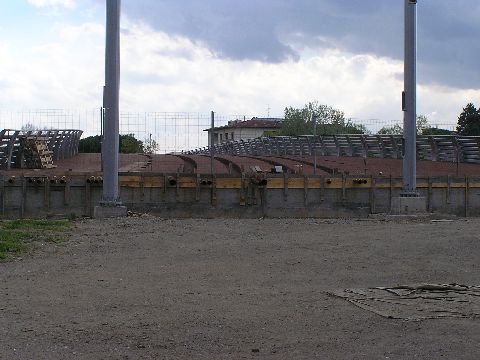
|
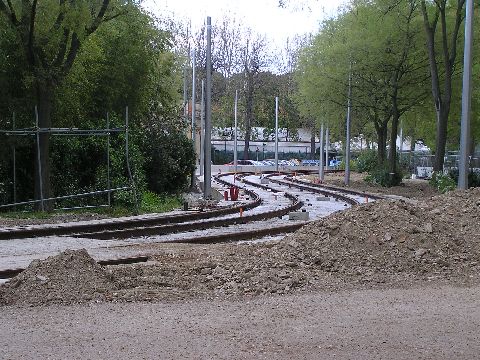
|
|
A new tram-only bridge brings the new line across the river Arno
into the Parco delle Cascine.
|
The line then runs through the eastern end of the park before
curving left around Pazza Vittorio Veneto.
|
|
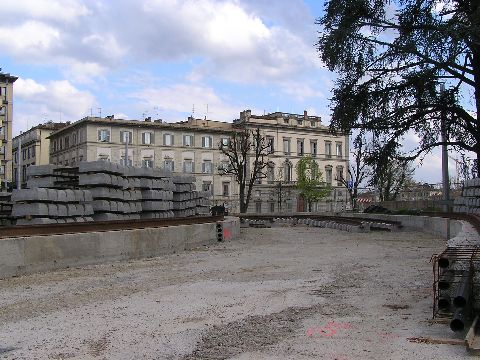
|
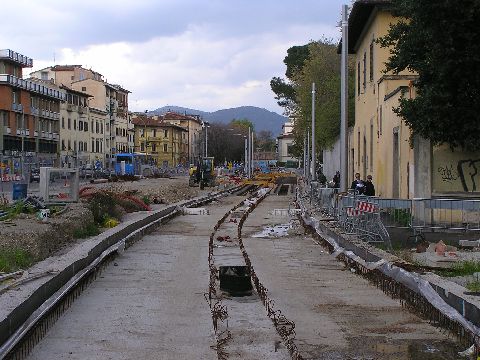
|
|
Track-laying is yet to take place on all of the broad loop which
takes the line over the road underpass at Piazza Vittorio to Viale
Fratelli Rosselli.
|
Viale Fratelli Rosselli is a wide road by Florence standards
- part of the ring of boulevards on the north side built along the
course of the old city wall.
|
|
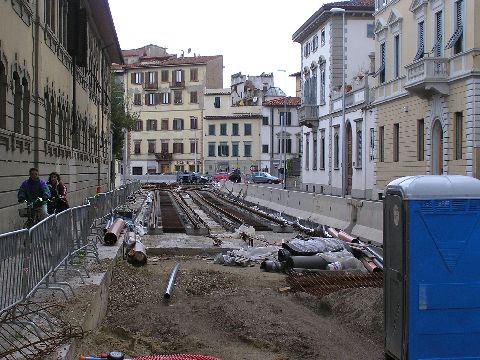
|
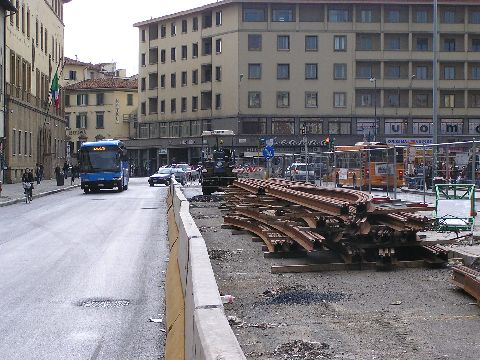
|
|
From Viale Fratelli Rosselli, the line turns into the narrow
Via Jacopo da Diacceto.
|
Although there are no works at this point, the line joins Via
Luigi Alamanni before turning sharp left into Piazza della stazione,
seen above.
|
Return to Florence 2016